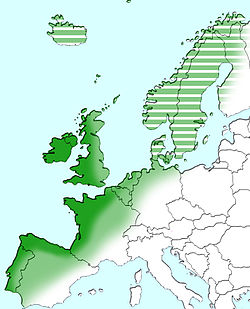Atlantic Europe

Atlantic Europe is a geographical and anthropological term for the western portion of Europe which borders the Atlantic Ocean. The term may refer to the idea of Atlantic Europe as a cultural unit and/or as an biogeographical region.
It comprises the western (Atlantic) part of Iberia, north and western France, Ireland and the United Kingdom. Some authors also include Iceland, the Low Countries, north Germany and Scandinavia.
Weather and overall physical conditions are relatively similar along this area (with the exception of parts of Scandinavia and the Baltic), resulting in similar landscapes with common endemic plant and animal species. From a strictly physical point of view most of the Atlantic European shoreline can be considered a single biogeographical region.[2] Physical geographers label this biogeographical area as the European Atlantic Domain, part of the Euro-Siberian botanic region.
Atlantic European culture
Origins
Archaeologists have noted that the prehistoric peoples of Atlantic Europe presented some common traits, as shown by artefacts and architectural styles found in the region which attest to at least some form of trade link. In addition, a number of genetic studies seem to interrelate specific groups of population in parts of Atlantic Europe in contrast with, for example, Central or Mediterranean Europe.[3] [4]
Some examples of early cultural contact are the European Megalithic Culture and the Atlantic Bronze Age, or "carp's tongue sword complex". This refers to an industry mainly based on the west coast of France and Brittany but which clearly had links with societies in Iberia and Britain, as evindenced by products such as the carp's tongue sword and the end winged axe, which were widely bought and sold along the routes of the Atlantic seaways.
Atlantic Europe is also a term often used in reference to the territory occupied by the Celtic peoples of western Europe.[5]
Atlantic European culture at present
A number of authors have postulated that there still is a cultural continuum in Atlantic Europe, forming a cultural unit which has its roots in prehistoric times but remained until today mostly thanks to sea trade. Geographers also mention the influence of the natural environment in the construction of a similar cultural landscape along the western European coasts. Some of the first geographers to consider this idea of Atlantic Europe were geographers Otero Pedrayo and Orlando Ribeiro. Pedrayo stated in his studies about Galicia that this territory was marked by a strong "Atlantic character", not Mediterranean, despite the fact of being part of a Mediterranean State (Spain). On the other hand, while researching about his native Portugal, Ribeiro deepened in the concepts of Atlantic Europe and Mediterranean Europe, linking central and southern Portugal to the Mediterranean culture and northern Portugal (together with Galicia) to a pan-Atlantic European culture.
This idea would be further developed from the 1950s onwards by authors such as P. Flatrès, Emyr Estyn Evans, A. Bouhier, Meynier, J. García Fernández, Patrick O'Flanagan, Barry Cunliffe, Carlos Ferrás Sexto and Xoán Paredes (among others). Patrick O'Flanagan, based on the theories of Pedrayo and Ribeiro, states that Atlantic Europe is a cultural reality that stretches along the coastal fringe of Europe, from Norway to North Portugal (down to the Coimbra area), and including Britain and Ireland.
Atlantic Europe in politics
There is a multi-national official institution, fostered by the European Union, which acts as a co-ordinator of Atlantic European regions and its interests. This is the Atlantic Arc Commission.[6] Yet, despite being operative since 1989, it only deals with four member States - Great Britain, France, Spain and Portugal - embracing a total of 26 regions. The Atlantic Arc Commission is one of the seven Geographical Commissions in the Conference of Peripheral Maritime Regions of Europe.
Notes
- ^ Atlantic Arc Commission.
- ^ Indicative map of the European biogeographical regions 2005.
- ^ Brian Donnelly (2004), We are not Celts at all but Galicians; DNA research links the Scots, Irish and Welsh to north-western Spain, The Herald (Glasgow - UK), p. 15.
- ^ Salas A, Comas D, Lareu MV, Bertranpetit J, Carracedo A., mtDNA analysis of the Galician population: a genetic edge of European variation., Eur J Hum Genet. 1998 Jul-Aug;6(4):365-75.
- ^ Modern Celtic realm - National Geographic.
- ^ Atlantic Arc Commission.
References
- Orlando Ribeiro, Portugal o Mediterrâneo e o Atlântico, Lisboa, 1945.
- E. E. Evans-Pritchard, The Atlantic Ends of Europe, Advancety Offsiders, London, 1958.
- H.N. Savory, Serpentiforms in Megalithic art: a link between Wales and the Iberian NW, in "Cadernos de Estudos Galegos" no. 84, p. 80-89, Santiago de Compostela, 1973
- Patrick O'Flanagan, "La Europa Atlántica: Pasado y presente. Una revisión del concepto y de la realidad'", in Actas Congreso Internacional: A periferia Atlántica de Europa: o desenvolvemento e os problemas socioculturais, Universidade de Santiago Compostela, 1992.
- Patrick O'Flanagan, "Galicia en el marco geográfico e histórico de la Europa Atlántica", in "Xeográfica" no. 1, p. 115-133, 2001.
- Barry Cunliffe, Facing the Ocean: The Atlantic and Its Peoples, 8000 BC to AD 1500, OUP, 2001.
See also
External links
- Haplogroup R1b distribution map
- Macdonald's Haplogroup map
- Monuments in Atlantic Europe
- Rock Art in Atlantic Europe
- From the Neolithic to the Atlantic Bronze Age
- Atlantic Arc Commission - The European organisation for governmental and economical cooperation of the regions of Atlantic Europe
- Conference of Cities of the Atlantic Arc
